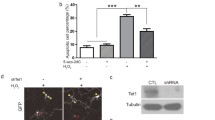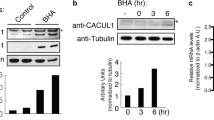Abstract
cAMP response element-binding (CREB) protein is a cellular transcription factor that mediates responses to different physiological and pathological signals. Using a model of human neuronal cells we demonstrate herein, that CREB is phosphorylated after oxidative stress induced by hydrogen peroxide. This phosphorylation is largely independent of PKA and of the canonical phosphoacceptor site at ser-133, and is accompanied by an upregulation of CREB expression at both mRNA and protein levels. In accordance with previous data, we show that CREB upregulation promotes cell survival and that its silencing results in an increment of apoptosis after oxidative stress. Interestingly, we also found that CREB promotes DNA repair after treatment with hydrogen peroxide. Using a cDNA microarray we found that CREB is responsible for the regulation of many genes involved in DNA repair and cell survival after oxidative injury. In summary, the neuroprotective effect mediated by CREB appears to follow three essential steps following oxidative injury. First, the upregulation of CREB expression that allows sufficient level of activated and phosphorylated protein is the primordial event that promotes the induction of genes of the DNA Damage Response. Then and when the DNA repair is effective, CREB induces detoxification and survival genes. This kinetics seems to be important to completely resolve oxidative-induced neuronal damages.







Similar content being viewed by others
Abbreviations
- H2O2 :
-
Hydrogen peroxide
- DDR:
-
DNA damage response
- Aβ:
-
Amyloid beta peptide
- CREB:
-
cAMP response element binding
- ROS:
-
Reactive oxygen species
- BER:
-
Base excision repair
- CNS:
-
Central nervous system
References
Hachem LD, Mothe AJ, Tator CH (2015) Effect of BDNF and other potential survival factors in models of in vitro oxidative stress on adult spinal cord-derived neural stem/progenitor cells. Biores Open Access 4(1):146–159
Kulkarni A, McNeill DR, Gleichmann M et al (2008) XRCC1 protects against the lethality of induced oxidative DNA damage in nondividing neural cells. Nucleic Acids Res 36:5111–5121. doi:10.1093/nar/gkn480
Belaidi AA, Bush AI (2015) Iron neurochemistry in Alzheimer’s disease and Parkinson’s disease: targets for therapeutics. J Neurochem. doi:10.1111/jnc.13425
Cleary JP, Walsh DM, Hofmeister JJ et al (2005) Natural oligomers of the amyloid-beta protein specifically disrupt cognitive function. Nat Neurosci 8:79–84. doi:10.1038/nn1372
Leon J, Sakumi K, Castillo E et al (2016) 8-Oxoguanine accumulation in mitochondrial DNA causes mitochondrial dysfunction and impairs neuritogenesis in cultured adult mouse cortical neurons under oxidative conditions. Sci Rep 6:22086. doi:10.1038/srep22086
Migliore L, Coppedè F (2009) Environmental-induced oxidative stress in neurodegenerative disorders and aging. Mutat Res 674:73–84. doi:10.1016/j.mrgentox.2008.09.013
Pregi N, Vittori D, Pérez G et al (2006) Effect of erythropoietin on staurosporine-induced apoptosis and differentiation of SH-SY5Y neuroblastoma cells. Biochim Biophys Acta 1763:238–246
Bartek J, Lukas J (2007) DNA damage checkpoints: from initiation to recovery or adaptation. Curr Opin Cell Biol 19:238–245. doi:10.1016/j.ceb.2007.02.009
Yang S-P, Bae D-G, Kang HJ et al (2004) Co-accumulation of vascular endothelial growth factor with beta-amyloid in the brain of patients with Alzheimer’s disease. Neurobiol Aging 25:283–290. doi:10.1016/S0197-4580(03)00111-8
Dell’Orco M, Milani P, Arrigoni L et al (2016) Hydrogen peroxide-mediated induction of SOD1 gene transcription is independent from Nrf2 in a cellular model of neurodegeneration. Biochim Biophys Acta 1859:315–323. doi:10.1016/j.bbagrm.2015.11.009
Jackson SP (2009) The DNA-damage response: new molecular insights and new approaches to cancer therapy. Biochem Soc Trans 37:483–494. doi:10.1042/BST0370483
Sedelnikova OA, Redon CE, Dickey JS et al (2010) Role of oxidatively induced DNA lesions in human pathogenesis. Mutat Res 704:152–159. doi:10.1016/j.mrrev.2009.12.005
Lu W, Ogasawara MA, Huang P (2007) Models of reactive oxygen species in cancer. Drug Discov Today Dis Models 4:67–73. doi:10.1016/j.ddmod.2007.10.005
Lala PK, Chakraborty C (2001) Role of nitric oxide in carcinogenesis and tumour progression. Lancet Oncol 2:149–156. doi:10.1016/S1470-2045(00)00256-4
Hussain S, Witt E, Huber PAJ et al (2003) Direct interaction of the Fanconi anaemia protein FANCG with BRCA2/FANCD1. Hum Mol Genet 12:2503–2510. doi:10.1093/hmg/ddg266
Tartier L, Gilchrist S, Burdak-Rothkamm S et al (2007) Cytoplasmic irradiation induces mitochondrial-dependent 53BP1 protein relocalization in irradiated and bystander cells. Cancer Res 67:5872–5879. doi:10.1158/0008-5472.CAN-07-0188
Kurfurstova D, Bartkova J, Vrtel R et al (2016) DNA damage signalling barrier, oxidative stress and treatment-relevant DNA repair factor alterations during progression of human prostate cancer. Mol Oncol. doi:10.1016/j.molonc.2016.02.005
Simoneau A, Ricard É, Weber S et al (2016) Chromosome-wide histone deacetylation by sirtuins prevents hyperactivation of DNA damage-induced signaling upon replicative stress. Nucleic Acids Res. doi:10.1093/nar/gkv1537
Bellacosa A, Drohat AC (2015) Role of base excision repair in maintaining the genetic and epigenetic integrity of CpG sites. DNA Rep (Amst) 32:33–42. doi:10.1016/j.dnarep.2015.04.011
Chou W-C, Hu L-Y, Hsiung C-N, Shen C-Y (2015) Initiation of the ATM-Chk2 DNA damage response through the base excision repair pathway. Carcinogenesis 36:832–840. doi:10.1093/carcin/bgv079
Maynard S, Schurman SH, Harboe C et al (2009) Base excision repair of oxidative DNA damage and association with cancer and aging. Carcinogenesis 30:2–10. doi:10.1093/carcin/bgn250
Lonze BE, Ginty DD (2002) Function and regulation of CREB family transcription factors in the nervous system. Neuron 35:605–623
Sakamoto K, Karelina K, Obrietan K (2011) CREB: a multifaceted regulator of neuronal plasticity and protection. J Neurochem 116:1–9. doi:10.1111/j.1471-4159.2010.07080.x
Gonzalez GA, Montminy MR (1989) Cyclic AMP stimulates somatostatin gene transcription by phosphorylation of CREB at serine 133. Cell 59:675–680
Gonzalez GA, Yamamoto KK, Fischer WH et al (1989) A cluster of phosphorylation sites on the cyclic AMP-regulated nuclear factor CREB predicted by its sequence. Nature 337:749–752. doi:10.1038/337749a0
Shi Y, Venkataraman SL, Dodson GE et al (2004) Direct regulation of CREB transcriptional activity by ATM in response to genotoxic stress. Proc Natl Acad Sci USA 101:5898–5903. doi:10.1073/pnas.0307718101
Sakamoto K, Huang B-W, Iwasaki K et al (2010) Regulation of genotoxic stress response by homeodomain-interacting protein kinase 2 through phosphorylation of cyclic AMP response element-binding protein at serine 271. Mol Biol Cell 21:2966–2974. doi:10.1091/mbc.E10-01-0015
Trinh AT, Kim SH, Chang H et al (2013) Cyclin-dependent kinase 1-dependent phosphorylation of cAMP response element-binding protein decreases chromatin occupancy. J Biol Chem 288:23765–23775. doi:10.1074/jbc.M113.464057
St-Pierre J, Drori S, Uldry M et al (2006) Suppression of reactive oxygen species and neurodegeneration by the PGC-1 transcriptional coactivators. Cell 127:397–408. doi:10.1016/j.cell.2006.09.024
Lee B, Cao R, Choi Y-S et al (2009) The CREB/CRE transcriptional pathway: protection against oxidative stress-mediated neuronal cell death. J Neurochem 108:1251–1265. doi:10.1111/j.1471-4159.2008.05864.x
Tan Y-W, Zhang S-J, Hoffmann T, Bading H (2012) Increasing levels of wild-type CREB up-regulates several activity-regulated inhibitor of death (AID) genes and promotes neuronal survival. BMC Neurosci 13:48. doi:10.1186/1471-2202-13-48
Mosmann T (1983) Rapid colorimetric assay for cellular growth and survival: application to proliferation and cytotoxicity assays. J Immunol Methods 65:55–63
Carcagno AL, Giono LE, Marazita MC et al (2012) E2F1 induces p19INK4d, a protein involved in the DNA damage response, following UV irradiation. Mol Cell Biochem 366:123–129. doi:10.1007/s11010-012-1289-8
Ceruti JM, Scassa ME, Fló JM et al (2005) Induction of p19INK4d in response to ultraviolet light improves DNA repair and confers resistance to apoptosis in neuroblastoma cells. Oncogene 24:4065–4080. doi:10.1038/sj.onc.1208570
Varone CL, Giono LE, Ochoa A et al (1999) Transcriptional regulation of 5-aminolevulinate synthase by phenobarbital and cAMP-dependent protein kinase. Arch Biochem Biophys 372:261–270. doi:10.1006/abbi.1999.1470
Verdeil G, Puthier D, Nguyen C et al (2002) Gene profiling approach to establish the molecular bases for partial versus full activation of naïve CD8 T lymphocytes. Ann N Y Acad Sci 975:68–76
Sherman BT, Huang DW, Tan Q et al (2007) DAVID knowledgebase: a gene-centered database integrating heterogeneous gene annotation resources to facilitate high-throughput gene functional analysis. BMC Bioinform 8:426. doi:10.1186/1471-2105-8-426
Yamamoto KK, Gonzalez GA, Biggs WH, Montminy MR (1988) Phosphorylation-induced binding and transcriptional efficacy of nuclear factor CREB. Nature 334:494–498. doi:10.1038/334494a0
Lee HJ, Mignacca RC, Sakamoto KM (1995) Transcriptional activation of egr-1 by granulocyte-macrophage colony-stimulating factor but not interleukin 3 requires phosphorylation of cAMP response element-binding protein (CREB) on serine 133. J Biol Chem 270:15979–15983
Yi C, He C (2013) DNA repair by reversal of DNA damage. Cold Spring Harb Perspect Biol 5:a012575. doi:10.1101/cshperspect.a012575
Huang DW, Sherman BT, Tan Q et al (2007) DAVID bioinformatics resources: expanded annotation database and novel algorithms to better extract biology from large gene lists. Nucleic Acids Res 35:W169–W175. doi:10.1093/nar/gkm415
Huang DW, Sherman BT, Lempicki RA (2009) Systematic and integrative analysis of large gene lists using DAVID bioinformatics resources. Nat Protoc 4:44–57. doi:10.1038/nprot.2008.211
Zou J, Crews F (2006) CREB and NF-kappaB transcription factors regulate sensitivity to excitotoxic and oxidative stress induced neuronal cell death. Cell Mol Neurobiol 26:385–405. doi:10.1007/s10571-006-9045-9
Volakakis N, Kadkhodaei B, Joodmardi E et al (2010) NR4A orphan nuclear receptors as mediators of CREB-dependent neuroprotection. Proc Natl Acad Sci USA 107:12317–12322. doi:10.1073/pnas.1007088107
Andreoli C, Leopardi P, Rossi S, Crebelli R (1999) Processing of DNA damage induced by hydrogen peroxide and methyl methanesulfonate in human lymphocytes: analysis by alkaline single cell gel electrophoresis and cytogenetic methods. Mutagenesis 14:497–504
Mantha AK, Sarkar B, Tell G (2014) A short review on the implications of base excision repair pathway for neurons: relevance to neurodegenerative diseases. Mitochondrion 16:38–49. doi:10.1016/j.mito.2013.10.007
Yang J-L, Tadokoro T, Keijzers G et al (2010) Neurons efficiently repair glutamate-induced oxidative DNA damage by a process involving CREB-mediated up-regulation of apurinic endonuclease 1. J Biol Chem 285:28191–28199. doi:10.1074/jbc.M109.082883
Li C, Hu Z, Lu J et al (2007) Genetic polymorphisms in DNA base-excision repair genes ADPRT, XRCC1, and APE1 and the risk of squamous cell carcinoma of the head and neck. Cancer 110:867–875. doi:10.1002/cncr.22861
Wittschieben BØ, Iwai S, Wood RD (2005) DDB1-DDB2 (xeroderma pigmentosum group E) protein complex recognizes a cyclobutane pyrimidine dimer, mismatches, apurinic/apyrimidinic sites, and compound lesions in DNA. J Biol Chem 280:39982–39989. doi:10.1074/jbc.M507854200
Miao F, Bouziane M, Dammann R et al (2000) 3-Methyladenine-DNA glycosylase (MPG protein) interacts with human RAD23 proteins. J Biol Chem 275:28433–28438. doi:10.1074/jbc.M001064200
Grombacher T, Mitra S, Kaina B (1996) Induction of the alkyltransferase (MGMT) gene by DNA damaging agents and the glucocorticoid dexamethasone and comparison with the response of base excision repair genes. Carcinogenesis 17:2329–2336
Shiyanov P, Nag A, Raychaudhuri P (1999) Cullin 4A associates with the UV-damaged DNA-binding protein DDB. J Biol Chem 274:35309–35312
Groisman R, Polanowska J, Kuraoka I et al (2003) The ubiquitin ligase activity in the DDB2 and CSA complexes is differentially regulated by the COP9 signalosome in response to DNA damage. Cell 113:357–367
Acknowledgements
This research was supported by grants from the University of Buenos Aires (UBA 2011–2013; UBA 2011-2014), the National Council of Scientific and Technical Research (CONICET, Argentina), and the National Agency for Scientific and Technologic Promotion (ANPCYT) (PICT 2012–2014; PICT 2010–2013).
Author information
Authors and Affiliations
Corresponding author
Additional information
Nicolás Pregi and Laura María Belluscio have contributed equally to this work.
Electronic supplementary material
Below is the link to the electronic supplementary material.
Rights and permissions
About this article
Cite this article
Pregi, N., Belluscio, L.M., Berardino, B.G. et al. Oxidative stress-induced CREB upregulation promotes DNA damage repair prior to neuronal cell death protection. Mol Cell Biochem 425, 9–24 (2017). https://doi.org/10.1007/s11010-016-2858-z
Received:
Accepted:
Published:
Issue Date:
DOI: https://doi.org/10.1007/s11010-016-2858-z




